

How to create custom forms in WordPress without using plugins? Forms are an integral part of a website.
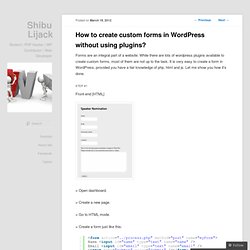
The Loop. Languages: English • Français • Italiano • 日本語 • Português do Brasil • Русский • 中文(简体) • 中文(繁體) • (Add your language) The Loop is PHP code used by WordPress to display posts.
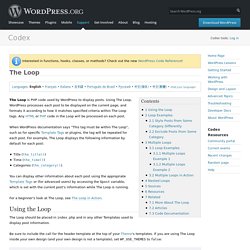
Using The Loop, WordPress processes each post to be displayed on the current page, and formats it according to how it matches specified criteria within The Loop tags. Any HTML or PHP code in the Loop will be processed on each post. When WordPress documentation says "This tag must be within The Loop", such as for specific Template Tags or plugins, the tag will be repeated for each post. For example, The Loop displays the following information by default for each post: You can display other information about each post using the appropriate Template Tags or (for advanced users) by accessing the $post variable, which is set with the current post's information while The Loop is running. For a beginner's look at The Loop, see The Loop in Action. Using the Loop The loop starts here: Custom Query Shortcode: Run a Loop inside Any Post/Page.
I had the occasion yesterday to have a page with a section on it where it would output a very specific set of other pages, which would need to change dynamically.

What I could have done is built a special page template for this page, and inside that template run a query_posts() to get these posts. But I wanted this page to remain editable from the admin. Mastering Conditional Statements and Tags for Tweaking WordPress Blogs. The conditional statements feature is an extremely useful and powerful feature in WordPress; still it remains unused in the development process.

You can achieve many things by the simple and smart use of these statements. Introduction to WordPress conditional tags. WordPress comes with something called conditional tags, which let’s you change how content is displayed depending on what conditions that are met.

For example, you can check if the user is on the frontpage, or if she is logged in or not. in this article we’ll go through how to use these conditional tags, and how they work. If you are familiar to PHP, this will be a walk in the park. Otherwise, dont worry, I’ll show you how it works. Editor Styles for Custom Post Types in WordPress 3.0. I’ve had some fun playing around with the recently released WordPress 3.0, Beta 1.

One of my new favorite additions is the add_editor_style() which allows you to assign a CSS file for the TinyMCE when editing posts, pages and the new custom post types. This is very handy to get closer to a WYSIWYG experience in WordPress’ editor and not having to preview the posts all the times while writing, to check where line breaks end up and so on (if you care about those things). I’m also loving the new Custom Post Types, and on one of my sites, I have setup a few different post types.
On the frontend I have different widths for posts, pages and my new WordPress 3.0 custom post type ‘portfolio. I wanted to reflect the different widths in my admin editor style sheet as well. Which sets the width for the editor. How to Float WordPress Admin Menu and Make it Sticky. Plugins and Resources for Improving User Interactivity with Wordpress. If there is a sense of community and vibrant life surrounding a blog it tends to be successful and ultimately popular – that is a fact.
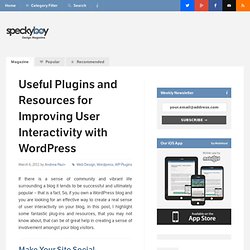
So, if you own a WordPress blog and you are looking for an effective way to create a real sense of user interactivity on your blog, in this post, I highlight some fantastic plug-ins and resources, that you may not know about, that can be of great help in creating a sense of involvement amongst your blog visitors. Make Your Site Social The Gigya Social optimization plug-in aggregates authentication and social APIs from Facebook, Twitter, Google, Microsoft, Yahoo, LinkedIn, AOL and other OAuth & OpenID providers, giving sites the ability to authenticate users via social network and OpenID providers and increase site traffic by allowing users to easily share content with their friends and followers. The plug-in is scalable and secure, using a standard authentication techniques to prevent account spoofing. Make Your Site Social Resources & Tutorials Digress.it.
How to Create a Custom Options Page in Wordpress. One thing that seems to define technology is that users like both ease of use and the ability to customize the appearance of everything they use.
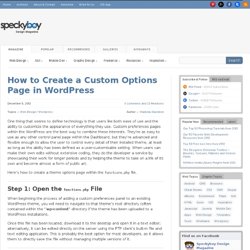
Custom preferences pages within the WordPress are the best way to combine these interests. They’re as easy to use as any other control panel page within the Dashboard, but they’re advanced and flexible enough to allow the user to control every detail of their installed theme, at least as long as the ability has been defined as a user-customizable setting.
When users can make their own edits without extensive coding, they do the developer a service by showcasing their work for longer periods and by helping the theme to take on a life of its own and become almost a form of public art. Here’s how to create a theme options page within the functions.php file. Step 1: Open the functions.php File Step 2: Defining Variables for Use Within the Preferences Page. Parse RSS Feeds as Content in WordPress. What most people do not know, is that WordPress is also quite capable of pulling in RSS content from outside blogs and parsing it for display within one of its many template files.
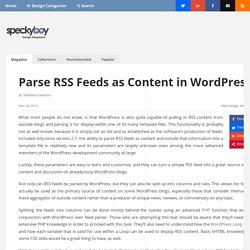
This functionality is probably not as well known because it is simply not as old and as established as the software’s production of feeds. Included only since version 2.7, the ability to parse RSS feeds as content and include that information into a template file is relatively new and its parameters are largely unknown even among the more advanced members of the WordPress development community at large. Luckily, these parameters are easy to learn and customize, and they can turn a simple RSS feed into a great source of extra content and discussion on already-busy WordPress blogs. Not only can RSS feeds be parsed by WordPress, but they can also be split up into columns and tabs.
Step 1: Utilize the Built-in Parsing Function to Pull the Feed in and Turn its XML into Content <? Pretty easy, right? Optimization/Cheat Sheet. Postline, A Theme Inspired by Facebook's Timeline. 28 Aug 2012 Are you a big fan of Facebook's Timeline feature?
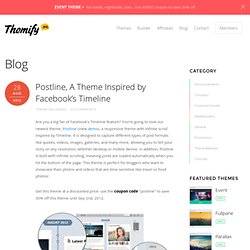
You're going to love our newest theme, Postline (view demo), a responsive theme with infinite scroll inspired by Timeline. It is designed to capture different types of post formats like quotes, videos, images, galleries, and many more, allowing you to tell your story on any resolution, whether desktop or mobile device. In addition, Postline is built with infinite scrolling, meaning posts are loaded automatically when you hit the bottom of the page. This theme is perfect for bloggers who want to showcase their photos and videos that are time-sensitive like travel or food photos! Get this theme at a discounted price: use the coupon code "postline" to save 30% off this theme until Sep 2nd, 2012.
Responsive Design The layout of Postline automatically adjusts to the width of the viewport so your story will be told on any resolution whether it is a large desktop display or small mobile screen. Timeline Layout. Wordpress Content Slider Plugins: 9 User-Friendly Examples. Featured sliders are all the rage right now, because they provide an easy way to showcase your best content and keep keep your visitors interested with instantly changing images. When searching for a plugin to handle your site’s featured content and/or images, it can be completely overwhelming, given the vast number available. Who knows which are any good? I want to save you an hour of research with this post. Goodbye, headaches. Hello, menus! As a theme developer, most of the support questions I get are about configuring menus. If you’re also a theme developer, you have probably run into the same questions I have.
The trouble is that a large majority of users want custom menus and no two menus are the same. There are tons of plugins that fix this problem in their own way. Even some theme developers have integrated menus systems into their themes. Unfortunately, all of these solutions are different. In this tutorial, I’ll walk you through the features of the new system and how to build this into your theme if you’re a developer. What the menu system offers. Wordpress jQuery dropdown menu tutorial. See a more recent article about how to integrate the Twitter Bootstrap dropdown menu with WordPress here The motivation for this article was to create a set of notes for myself to speed up the process of creating a WordPress drop down menu with jQuery, as I found myself needing to add this functionality to most projects. I decided to turn it into a tutorial and share it with the world. If you have any issues or if you have a more efficient way of achieving the same end result, I'd love to hear from you.
Step 1: Register the menu in functions.php Add the code to your functions.php file where 'primary' is the theme_location used in your template file and 'Header Navigation' is the description appearing in the Appearance > Menus section of your WordPress back end. In this case we are only registering one menu but if you wish to add more simply duplicate the line within array () with something like: 'secondary' => __('Sidebar Navigation', ''), Step 2: Call the menu in your theme.
Step 3. Useful WordPress Tools, Themes and Plugins. If you’re looking for some great ways to improve your WordPress workflow, read on for a massive collection of free themes, plugins, tools and tutorials. These resources were all linked via the Smashing Magazine Twitter stream, Facebook stream, and other social-media streams around the Web. These resources have now been organized and consolidated for easy reference to help you get the most out of the world’s most popular publishing platform. We hope that you’ll find these resources helpful and valuable. 20 Useful WordPress PopUp Plugin Collection.
How can you tell that a blog or a website is successful? Obviously, some would say that it depends on the traffic, but actually, traffic alone is not everything. Often the goal for a website is to generate sales, increase subscription rates, and develop loyal readership. Internet marketers are more familiar to this principle than any others are working online, and part of their success formula is the use of forceful and effective call to action, which is oftentimes contained in a pop-up box or lightbox. Recently the use of technologies like jQuery have made it possible to create modal windows that are actually part of the existing page. This makes blocking them very hard when using Pop-up window blockers.
How to Show a Popup on Specific WordPress Posts or Pages. How to Code an Awesome Categories Menu for Your WordPress Site. How To Customize The WordPress Admin Easily. Using Custom Post Types to Create a Killer Portfolio. Part 3: Custom Fields vs Custom Post Types vs Custom Taxonomies. In the first part of this two-part series, we explored the three different types of custom content you can create with WordPress and looked at the uses of each of them. Using Custom Post Types to Create a Killer Portfolio. Browser Support. The Best Way to Track "Not Found" 404 Errors in a WordPress Site. So, you want to know about every 404 on your site. There are plugins that do this, but they all suffer from one fatal problem. Plugins such as these all fail: The Problem with These Plugins They fail because tracking pageviews is not easy.
Web pages are not only accessed by human users. WordPress theme - The Anatomy, an Infographic. Index.php – home The index file controls what the homepage of your WordPress theme looks like. By default it is a loop that queries and then displays the most recent blog posts, with a link in the bottom to view previous posts. How To Migrate Your Locally Developed Wordpress Site To A Live Server. Requirements I’m going to assume that you already have a local server running, and are able to both access the files as well as the database through PHPMyAdmin.
How to Sync A Local And Remote WordPress Blog. WordPress: Manual Uninstall of W3 Total Cache. The W3 Total Cache plugin is the gold standard caching plugin for WordPress. An Outstanding Collection of Resources for WordPress Content Sliders. Posted by Daniel in Wordpress on February 21st, 2011 with 11 Comments. WordPress Support – The 10 Best Sites to Get WordPress Help. E Plugins { Advanced Custom Fields. WordPress Custom Fields 101: Tips, Tricks, and Hacks. Turn your blog into anything: 13 unusual uses for WordPress. WordPress Consultant: Judith Kallos, At Your Service... How To Tutorials. 10 incredibly cool WordPress shortcodes.
25 Free Premium WordPress Themes For Portfolio Websites. 30 Grid-Based WordPress Themes. 80+ Best WordPress Magazine Themes. Recent Posts With Thumbnails In Wordpress Without A Plugin. Custom post types in WordPress. How to Set Up Custom Wordpress Category Templates in Four Easy Steps. 10 WordPress Hacks to Make your Life even Easier. Top 50 WordPress Plugins for 2011 to Zoom SEO, SMO & Audience Engagement. WordPress Support – The 10 Best Sites to Get WordPress Help. 34 Free WordPress Theme Frameworks and Starter Themes (With A Comparison Chart) 15 Most Downloaded Free Minimal Wordpress Themes. 40 Stylish, Minimal and Clean Free Wordpress Themes. 10 Blank/Naked Wordpress Themes Perfect for Development. Rapidly create sites with HTML5 Boilerplate and Blueprint CSS or 960.gs. How To Build A Media Site On WordPress (Part 1) - Smashing WordPress. 10 Wordpress Plugins to Add Ratings and Polls to your blog.
14 Essential Wordpress Development and Design Cheat Sheets. 24 Stable WordPress Plugins For A Better Publishing Experience. 10 Best Twitter Tools, Plugins, Widgets for Wordpress Blogs. 20 Best WordPress Slider Plugin Collection. Top WordPress Plugins Every Blog Should Have. How to Use Wordpress Post Types and Taxonomies. How to Use Wordpress Conditional Statements - How To's Article by Addicott Web, Chicago, IL and Raleigh, NC Wordpress Website Design. Digging into WordPress. Different single post template per category wordpress - Nilesh Shiragave PHP. WPSeek.com - A WordPress-centric search engine for devs and theme authors. 10 super useful WordPress shortcodes. The 15 Best WordPress Plugins to Use in 2011.
5 Tools for Managing Multiple WordPress Sites from One Location. Import and Display RSS Feeds in WordPress. 15+ WordPress Menu Plugins For Better Navigation. Slick Social "Side-Out" Buttons in WordPress.